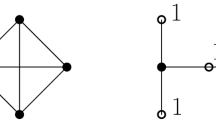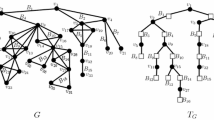Abstract
Let G(V, E) be a simple, connected and undirected graph. A dominating set \(S \subseteq V\) is called a 2-secure dominating set (2-SDS) in G, if for each pair of distinct vertices \(v_1,v_2 \in V\) there exists a pair of distinct vertices \(u_1,u_2 \in S\) such that \(u_1 \in N[v_1]\), \(u_2 \in N[v_2]\) and \((S {\setminus } \{u_1,u_2\}) \cup \{v_1,v_2 \}\) is a dominating set in G. The size of a minimum 2-SDS in G is said to be 2-secure domination number denoted by \(\gamma _{2s}(G)\). The 2-SDM problem is to check if an input graph G has a 2-SDS S, with \( \vert S \vert \le k\), where \( k \in \mathbb {Z}^+ \). It is proved that for bipartite graphs 2-SDM is NP-complete. In this paper, we prove that the 2-SDM problem is NP-complete for planar graphs and doubly chordal graphs, a subclass of chordal graphs. We reinforce the existing NP-complete result for bipartite graphs, by proving 2-SDM is NP-complete for some subclasses of bipartite graphs specifically, comb convex bipartite and star convex bipartite graphs. We prove that this problem is linear time solvable for bounded tree-width graphs. We also show that the 2-SDM is W[2]-hard even for split graphs. The M2SDS problem is to find a 2-SDS of minimum size in the given graph. We give a \( \varDelta +1 \)-approximation algorithm for M2SDS, where \( \varDelta \) is the maximum degree of the given graph and prove that M2SDS cannot be approximated within \( (1 - \epsilon ) \ln (\vert V \vert ) \) for any \( \epsilon > 0 \) unless \( NP \subseteq DTIME(\vert V \vert ^{ O(\log \log \vert V \vert )}) \). Finally, we prove that the M2SDS is APX-complete for graphs with \(\varDelta =4.\)






Similar content being viewed by others
References
Alimonti P, Kann V (2000) Some apx-completeness results for cubic graphs. Theoret Comput Sci 237(1–2):123–134
Brandstädt A, Chepoi VD, Dragan FF (1998) The algorithmic use of hypertree structure and maximum neighbourhood orderings. Discrete Appl Math 82(1–3):43–77
Chlebík M, Chlebíková J (2008) Approximation hardness of dominating set problems in bounded degree graphs. Inform Comput 206(11):1264–1275
Courcelle B (1990) The monadic second-order logic of graphs. I. Recognizable sets of finite graphs. Inform Computat 85(1):12–75
Garey MR, Johnson David S (1977) The rectilinear Steiner tree problem is NP-complete. SIAM J Appl Math 32(4):826–834
Garey MR, Johnson MS (2002) Computers and intractability, vol 29. W.H. Freeman, New York
Gonzalez Teofilo F (1985) Clustering to minimize the maximum intercluster distance. Theor Comput Sci 38:293–306
Haynes TW, Hedetniemi S, Slater P (1998) Fundamentals of domination in graphs. CRC Press, London
Henning Michael A, Arti P (2019) Algorithmic aspects of semitotal domination in graphs. Theor Comput Sci 766:46–57
Jakkepalli PK, Subba Reddy PV (2019) Algorithmic aspects of secure connected domination in graphs. Discuss Math Graph Theory. https://doi.org/10.7151/dmgt.2260
Jakkepalli PK, Subba Reddy PV (2020) Algorithmic aspects of some variants of domination in graphs. Analele Stiintifice ale Universitatii Ovidius Constanta, Seria Matematica 28(3):153–170
Jiang W, Liu T, Ren T, Xu K (2011) Two hardness results on feedback vertex sets. In: Frontiers in algorithmics and algorithmic aspects in information and management. Springer, pp 233–243
Klasing R, Laforest C (2004) Hardness results and approximation algorithms of k-tuple domination in graphs. Inform Process Lett 89(2):75–83
Lad D, Subba Reddy PV, Pavan Kumar J (2017) Complexity issues of variants of secure domination in graphs. Electron Notes Discrete Math 63:77–84
Leiserson CE, Rivest RL, Cormen TH, Stein C (2001) Introduction to algorithms, vol 6. MIT Press, Cambridge
Moscarini M (1993) Doubly chordal graphs, Steiner trees, and connected domination. Networks 23(1):59–69
Raman V, Saurabh S (2008) Short cycles make W-hard problems hard: FPT algorithms for W-hard problems in graphs with no short cycles. Algorithmica 52(2):203–225
West DB (1996) Introduction to graph theory, vol 2. Prentice Hall, Upper Saddle River
Author information
Authors and Affiliations
Corresponding author
Additional information
Publisher's Note
Springer Nature remains neutral with regard to jurisdictional claims in published maps and institutional affiliations.
Rights and permissions
About this article
Cite this article
Jakkepalli, P.K., Palagiri, V.S.R. Algorithmic aspects of 2-secure domination in graphs. J Comb Optim 42, 56–70 (2021). https://doi.org/10.1007/s10878-021-00739-9
Accepted:
Published:
Issue Date:
DOI: https://doi.org/10.1007/s10878-021-00739-9




